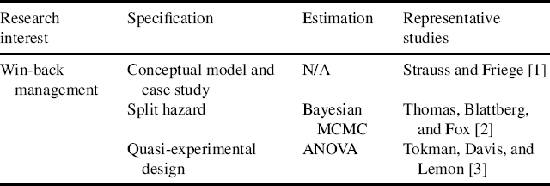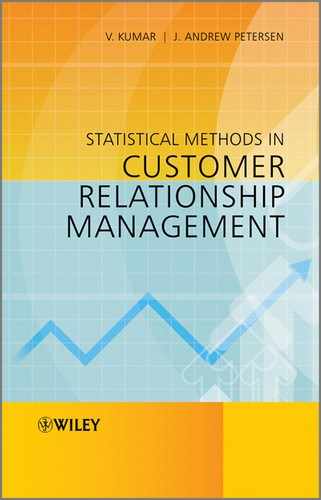7.1 Introduction
Managers usually think customer churn is the end of a customer's life cycle. But it does not have to be the end of the life cycle. Companies can still win the lost customers back and give them a second life. Unlike new customers, lost customers have certain knowledge about the products and services of the company and have their own judgment on the attributes and functions of the products and services. On the one hand, it is easier to approach lost customers since they are familiar with the company. On the other hand, lost customers often switch merchandisers because they are not satisfied with the product, so it is not necessarily easy to change their attitude and persuade them to come back. We also have to consider whether it is worth trying to bring the customers back to the firm – not all customers are worth chasing after they leave the firm.
Once we determine when a customer is likely to churn (see Chapter 6 for a detailed analysis on determining the probability of churn), we have to decide whether it is in the firm's best interest to attempt to win the customer back. So, there are several key questions that should be answered. These include:
- Should we intervene with the customer churn?
- How should we approach the customers to win them back?
The answers to each of these questions will drive the optimal customer win-back strategy. There have been a few research studies in the area, although research in customer win-back is still scarce. We review the representative studies of customer win-back here in Table 7.1. To provide a comprehensive understanding of how to model customer win-back, we will review the issues in the studies one by one along with the related modeling techniques. We will also provide an empirical example at the end of the chapter which will demonstrate how to apply this knowledge to a representative sample of customers from a B2C firm.
Table 7.1 Review of customer win-back models.

Similar to customer acquisition and customer retention models, the first question that needs to be answered is whether the firm's customers purchase in a contractual versus non-contractual manner. In most instances this will determine the type of statistical model that needs to be used in order to gain any insights from the data.
7.1.1 Data for Empirical Examples
In this chapter we will be providing a description of the key modeling frameworks that attempt to answer each key research question raised at the beginning of the chapter. We will also be providing an empirical example at the end of the chapter which will show how sample data can be used to answer these key research questions. For the empirical example we provide a dataset titled ‘Customer Win-back.’ In this dataset you will find a representative sample of 500 customers and former customers from a typical B2C firm. The data include the following variables:
| Variable | |
| Customer | Customer number (from 1 to 500) |
| Reacquire | 1 if the customer is reacquired, 0 if not |
| Duration_2 | Time in days of the customer's second life cycle with the company, 0 if not reacquired |
| SCLV | The CLV of the customer in the second life cycle |
| Duration_1 | Time in days of the customer's first life cycle with the company |
| Offer | The value of the offer provided to the customer for reacquisition |
| Duration_lapse | Time in days since the customer was lost to when the offer to reacquire was given |
| Price_Change | The increase (or decrease) in price of the subscription the customer received between the first life cycle and the second life cycle, 0 if not reacquired |
| Gender | 1 if male, 0 if female |
| Age | Age in years of the customer at the time of the attempt to reacquire |
These data will be used for the empirical example at the end of the chapter, which will help us to understand the drivers and likelihood of customer win-back.
